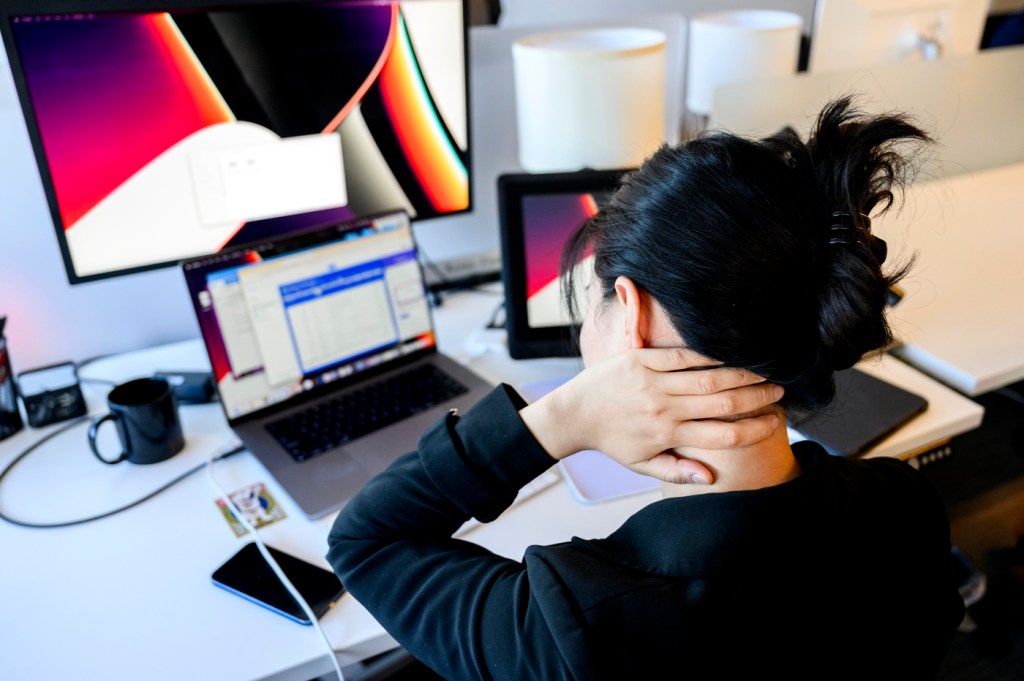‘Tech neck is the real deal.’ Why pain is on the rise from looking down at laptops and phones — and what to do about it

In recent years, chiropractor Scott Diamond has observed an explosion of patients, both adults and teens, seeking relief from “tech neck” and other painful conditions caused by prolonged use of laptops, tablets and cellphones.
“I have seen a significant uptick in symptoms associated with rounded hunched posture from prolonged use of smart devices, and overall sedentary time,” says Diamond, a Northeastern University graduate who runs a clinic in Boston.
“Tech neck is the real deal,” he says.
Diamond and Alycia Markowski, a Northeastern clinical professor of physical therapy, spoke to Northeastern Global News about what causes tech neck and how to prevent it from putting a crimp in your day.
Their tips range from purchasing the right office chair to using a towel or pillow to reduce back strain.
There are also special glasses people can wear that can reduce the eyestrain and headaches associated with computer work.
And don’t forget the vertical mouse.
The 42-pound head
It is not laptops, tablets and cellphones that cause tech neck, but the ergonomically incorrect use of them.
On a laptop, Markowski says, “You’re always looking down at your computer; your shoulders are slumped; your posture is poor; and that affects your neck.”
The resulting chronic neck and shoulder pains known as tech neck, or sometimes called “text neck,” are actually repetitive stress injuries, she says.
“If your shoulders are not relaxed, that’s when you get neck pain. You get headache pain and shoulder pain. If you’re hunched over, all these muscles are active for the entire time you’re sitting there at the computer,” Markowski says.
Diamond says to consider this: every one inch a person inclines their neck forward adds 10 pounds to the weight of the head pulling on the neck.
Move forward enough and the effective weight of the head is 42 pounds, he says.
Look straight ahead, not up or down
To lighten the load, take a break from your laptop and look straight ahead at a monitor, says Markowski, who specializes in injuries to muscles and tissues around the spinal column.
Make sure your desktop arrangement is ergonomically correct by connecting a laptop with a monitor, she says.
“Your eyes should be level with the top of the screen so you’re not looking down,” Markowski says.
“We want to do our best to get the top third of the text on the screen to be at eye level,” Diamond says.
“A laptop was really designed for people to use on a plane flight from New York to Washington, D.C.,” he says. “It’s not designed for using eight to 10 hours a day.”
.

And that means it’s not meant for teens and young children to spend hours on it doing their homework, Diamond says.
He says to make an ergonomically correct setup for young students by getting a laptop stand and also connecting the laptop to an external keyboard with a mouse so they are not hunched over a small keyboard.
Get all the right angles
“Think about 90-degree angles. When you’re sitting at a desk, your feet should be on the ground; your knees should be at a 90-degree angle and your hips should be at a 90-degree angle.”
Arms should be at a 90-degree angle to the table, as well, Markowski says.
“Your elbows should be at a 90-degree angle and your wrists almost neutral.”
If you’re seated correctly at a right angle to the work surface but you find your feet dangling in the air, use a stool to support your feet, Markowski says.
“That protects your back from arching too much. You want your back in a neutral position.”
The key to the right chair
“Your chair is probably one of the most important pieces” to maintaining proper posture at work, Markowski says.
Pick one with adjustable armrests, she says. “You want to have mobile armrests that you can lift up so that when you’re sitting, your shoulders are supported and relaxed” — not up by your ears.
Some chairs force people to sit too far back and lean forward to view the computer screen, which also contributes to bad posture and stress and strain, Markowski says.
She suggests using lumbar support to keep the body situated in a forward seating position. A rolled up towel or scarf will serve in a pinch if a lumbar support pillow is not available.
Featured Posts
“The other thing I like is that some of the office chairs tilt. If you can tilt your chair a little bit so the front part of the chair is lower than the back part of the chair, it puts your pelvis into a little bit of an anterior rotation and creates a neutral spine,” Markowski says.
She says even if a chair doesn’t tilt, people can get the same effect by putting a rolled up towel under their sit bones, which are the bones under the flesh of the buttocks you sit on.
“A good pelvic position helps our back because our muscles are more relaxed and not fighting gravity,” Markowski says.
Stand up, move around
Changing positions and standing for a bit can also help prevent stress and strain by engaging different muscles, especially one’s core muscles, she says.
If your employer provides a specialized electric desk with adjustable heights, use it.
If that’s not in the company budget, see about acquiring a small platform at a cost of $100 to $200 that will allow you to switch between sitting and standing up at your desktop, Markowski says.
Taking breaks to move around is important, she says.
“Your body is not meant to sit. We need to lubricate it, and movement lubricates our body,” Markowski says. “I tell people to set an alarm as a reminder to move, walk around and stretch every hour at a minimum.”
Sitting with a rounded back and tucked chin over a cellphone, tablet or laptop can interrupt respiration and breathing and make the user tired, Diamond says.
“Sit upright, lean back a little and take a deep breath.” Sitting with a rounded back and tucked chin affects the immune system, Diamond says. “Make sure you get out of your chair.”
Check out computer screen glasses
People who use reading glasses or progressive lenses often get back pain because they lean into their computer to read the screen, Markowski says.
“They’re trying to come closer, because their focal zone is a reading focal zone, not a computer focal zone.”
“I tell these people to go to their optometrist or eye clinic to see about getting computer glasses that focus at the level of the computer,” Markowski says.
Computer screen glasses are a specific type of progressive lenses designed to help users switch from the intermediate range of vision where their computer screens are to close up ranges for documents and other printed materials.
“Using computer glasses makes a huge difference for your back and your neck position,” Markowski says.
The vertical mouse
A vertical or angled mouse offers protection from carpal tunnel syndrome and other injuries to the neck, shoulder, wrist and elbow, Diamond says.
Keeping your palm flat to the desk surface is unnatural — the vertical keyboard feels more natural, like a handshake, he says.
Diamond says if people stick with a standard mouse, he recommends they use their opposite hand for five minutes twice a week.
Will your kids get ‘tech neck’?
And it’s not just adults who are dealing with tech neck, Diamond says.
Parents are talking to him about their concerns for their children and more teens are seeking his services, he says.
“I would say there are more teens with more issues,” Diamond says.
“I can tell you that neck pain is a common complaint,” says Markowski, who has two teenage children with lots of friends.
“The young spine is much more adaptable to prolonged stress, and once the children get up and run around, the symptoms are gone,” she says.
Markowski says she’s more concerned about children not getting enough exercise due to a fixation with electronics.
“Get up and move around. Exercise is key. Go for a long walk at lunch. If you’re in one position, you want to get in the opposite position when you’re stretching.”
“The more breaks you take from sitting, the better off you’ll be,” Markowski says.










